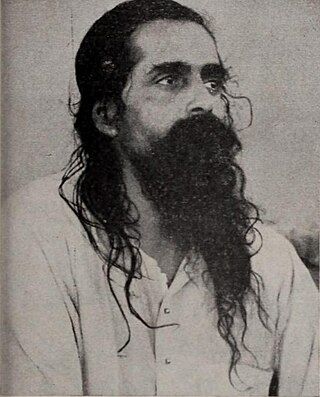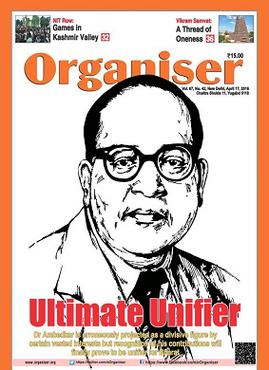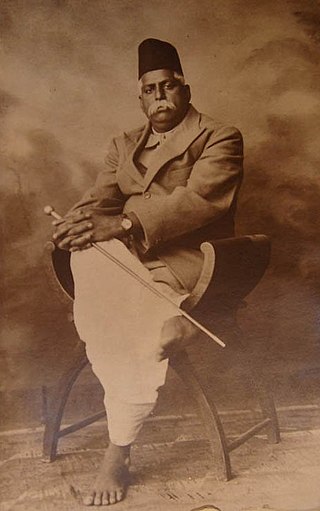
Rashtriya Swayamsevak Sangh is an Indian right-wing, Hindu nationalist volunteer paramilitary organisation. It is the progenitor and leader of a large body of organisations called the Sangh Parivar, which has developed a presence in all facets of Indian society and includes the Bharatiya Janata Party, the ruling political party under Narendra Modi, the 14th prime minister of India. Mohan Bhagwat has served as the Sarsanghchalak of the RSS since March 2009.
Hindutva is a political ideology encompassing the cultural justification of Hindu nationalism and the belief in establishing Hindu hegemony within India. The political ideology was formulated by Vinayak Damodar Savarkar in 1922. It is used by the Rashtriya Swayamsevak Sangh (RSS), the Vishva Hindu Parishad (VHP), the Bharatiya Janata Party (BJP) and other organisations, collectively called the Sangh Parivar.

Keshav Baliram Hedgewar, also known by his moniker Doctorji, was an Indian political-social activist, physician and the founder of the Rashtriya Swayamsevak Sangh (RSS). Hedgewar founded the RSS in Nagpur in 1925, based on the ideology of Hindutva with the intention of creating a Hindu Rashtra.
Vinay Katiyar is a politician and the founder-president of Bajrang Dal, the youth wing of the Hindu nationalist organisation Vishwa Hindu Parishad (VHP) in India. He has served as an All India General Secretary of the Bharatiya Janata Party (BJP), and as a Member of Parliament in both the Lok Sabha and the Rajya Sabha.

Madhav Sadashivrao Golwalkar, popularly known as Guruji, was the second Sarsanghchalak ("Chief") of the Rashtriya Swayamsevak Sangh (RSS). Golwalkar is considered one of the most influential and prominent figures among Rashtriya Swayamsevak Sangh by his followers.

Hindu Swayamsevak Sangh is a non-profit, social, educational, and cultural organization of the Hindus living outside India. It was founded in 1940s in Kenya, it is currently active in 156 countries and estimates 3289 branches.

Organiser is a mouthpiece of the Hindutva voluntary organisation Rashtriya Swayamsevak Sangh (RSS). It was launched as a newspaper in 1947 in the weeks before the Partition of India. The newspaper has been edited by A. R. Nair, K. R. Malkani, L. K. Advani, V. P. Bhatia, Seshadri Chari and Dr R. Balashanker. It has promoted misinformation on many occasions.

Madhukar Dattatraya Deoras, was the third Sarsanghchalak of the Rashtriya Swayamsevak Sangh (RSS).

The Rashtra Sevika Samiti is a Hindu nationalist women's organisation that parallels the Rashtriya Swayamsevak Sangh (RSS) for men. Even though it is often referred to as the "Sister" of the RSS, the organisation claims that it is independent of the RSS while sharing its ideology. Membership and leadership is embraced to women and its activities are directed to nationalist devotion and mobilisation of Hindu women.

Eknath Ramakrishna Ranade was a social activist and right-wing leader. He joined the Rashtriya Swayamsevak Sangh (RSS) when in school and was its general secretary from 1956 to 1962.
Hindu nationalism has been collectively referred to as the expression of social and political thought, based on the native spiritual and cultural traditions of the Indian subcontinent. "Hindu nationalism" is a simplistic translation of हिन्दू राष्ट्रवाद. It is better described as "Hindu polity".

The 1969 Gujarat riots involved communal violence between Hindus and Muslims during September–October 1969, in Gujarat, India. The violence was Gujarat's first major riot that involved massacre, arson, and looting on a large scale. It was the most deadly Hindu-Muslim violence since the partition of India in 1947, and remained so until the 1989 Bhagalpur violence.
The 1970 Bhiwandi riots were religious riots which occurred between 7 and 8 May in the Indian towns of Bhiwandi, Jalgaon and Mahad, between Hindus and Muslims. The riots caused the deaths of over 250 people; the Justice Madon commission, which investigated the riots, stated that 142 Muslims and 20 Hindus had been killed in Bhiwandi alone, and 50 Muslims and 17 Hindus in the surrounding areas. The commission strongly criticized the police for anti-Muslim bias in the aftermath of the riots, and also criticized the Shiv Sena, a Hindu-nationalist political party, for its role in the violence.
Laxman Vasudev Paranjape, was a member of the Hindu nationalist organisation Rashtriya Swayamsevak Sangh (RSS), along with its first Sarsanghchalak Keshav Baliram Hedgewar. Paranjape also served as the Acting Sarsanghchalak (1930–1931) when Hedgewar went to jail during the Forest Satyagraha.
Umakant Keshav Apte, also known as Babasaheb Apte, was one of the first pracharaks of the Hindu nationalist organisation Rashtriya Swayamsevak Sangh (RSS), taking initiation from its founder K. B. Hedgewar. Upon his death, the Babasaheb Apte Smarak Samiti was set up in his honour by RSS pracharak Moropant Pingle, which has been active in commissioning and publishing research on the history of ancient India.
Prabhakar Balwant Dani was a member of the Rashtriya Swayamsevak Sangh (RSS), a Hindu nationalist organization in India. He served as a pracharak of the organization. He served in senior positions of the RSS and played a large role in spreading the RSS network in the erstwhile Indian state of Madhya Bharat.
These are the references for further information regarding the Sangh Parivar.

Hedgewar Smruti Mandir (HSM) is a memorial in Reshimbagh, Nagpur, Maharashtra, India dedicated to K. B. Hedgewar and M. S. Golwalkar, who were the first two leaders of the Hindu nationalist organisation Rashtriya Swayamsevak Sangh (RSS). It was inaugurated in 1962. It was granted tourism status on the recommendation of the Maharashtra Tourism Development Corporation (MTDC) in 2017, but this decision is mired in controversy.

Rama Navami is a Hindu festival celebrating the birthday of Hindu deity Rama. It falls on the 9th day of the Chaitra month every year in the Hindu calendar, usually during the months of March–April. At least since 1979, if not earlier, This festival often involves processions of Hindu worshipers through cities, including Muslim-majority regions. These displays, often considered provocative, have repeatedly led to violence between Hindu and Muslim communities. Scholar Paul Brass states that Rama himself has been turned into a political emblem of the RSS family of organisations, and the Rama Navami processions are "led by or turned into provocative displays" by Hindutva organisations such as the Vishva Hindu Parishad (VHP) and Bajrang Dal. However, he fails to mention that Ram Navami processions were common in India, and other parts of the world where Hindus reside. These processions occurred much before VHP and Bajrang Dal even existed.











